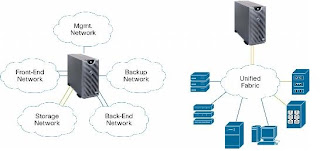- Front End Network. This is basically the primary public facing network and the one connecting to the Internet or large corporate network.
- Storage Network. This is the network connecting all the servers to the various storage arrays. You'll primarily see fiber channel technology being used and specialized SAN fabric switches used for connectivity.
- Back End Network. This is generally the network connecting all the servers to the various backup solutions providing backup/restore services to the environment.
- Management Network. This is a back end network of sorts but has a primary focus of providing management services to the environment. A management network typically provides the transport used by the management entity or NOC to gain remote access to the environment.
- InfiniBand Network. This network uses InfiniBand technology for high performance clustered computing.

It would surely make life much simpler from an administrative standpoint and there are several obvious cost advantages by making this a reality (fewer NICs, HBAs, cabling, fiber, switch types, etc.). Cisco's Data Center Ethernet promises to help do just that.
Ethernet is already the predominant choice for connecting network resources in the data center. It's ubiquitous, understood by engineers/developers around the globe and has stood the test of time against several challenger technologies. Cisco has basically built upon what we know as Ethernet. Cisco's Data Center Ethernet is basically a collection of Ethernet design technologies designed to improve and expand the role of Ethernet networking in the data center. These technologies include:
- Priority-based Flow Control (PFC). PFC is an enhancement to the pause mechanism within Ethernet. The current Ethernet pause option stops all the traffic on the entire link to control traffic flow. PFC creates eight virtual links on each physical link and allows any of these links to be paused independent of the others. When I was at Cisco a few weeks ago we covered this in detail. As a joke I asked them if they had 8 channels because Ethernet cabling has 8 separate wires (I know, networking jokes are quite complicated). They laughed and said that was in fact where the idea came from. They originally intended to send each virtual link down a different physical wire. It was funny for all of us anyway.
- Enhanced Transmission Selection. PFC can create eight distinct virtual link types on a physical link, and it can be advantageous to have different traffic classes defined within each virtual link. Traffic within the same PFC class can be grouped together and yet treated differently within each group. Enhanced Transmission Selection (ETS) provides prioritized processing based on bandwidth allocation, low latency, or best effort, resulting in per-group traffic class allocation.
- Data Center Bridging Exchange Protocol (DCBX). Data Center Bridging Exchange (DCBX) Protocol is a discovery and capability exchange protocol that is used by Cisco DCE products to discover peers in Cisco Data Center Ethernet networks and exchange configuration information between Cisco DCE switches.
- Congestion Notification. Traffic management that pushes congestion to the edge of the network by instructing rate limiters to shape the traffic causing the congestion.

No comments:
Post a Comment